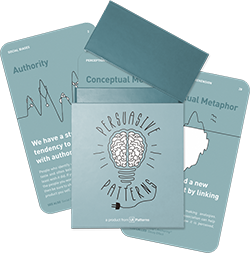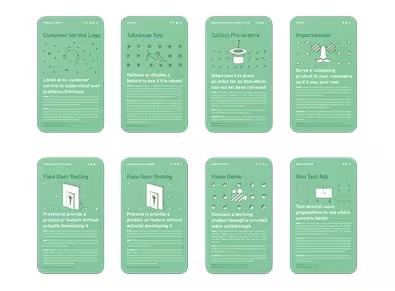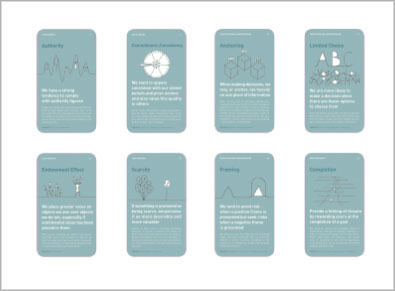Cognitive Dissonance
Design Pattern
Problem summary
When we do something that is not in line with our beliefs, we change our beliefs
Usage
Dissonance theory applies to all situations involving attitude formation and change. It is especially relevant to decision-making and problem-solving.
- Use when you want to promote self-reflection and self-awareness. For instance, when designing health apps that highlight the discrepancy between users’ desired health goals and their current habits.
- Use when you aim to drive users towards a particular behavior change, such as transitioning from a free to a paid subscription by making them aware of the value they’re missing out on.
- Use when the goal is to reinforce positive behavior. For example, eco-friendly apps may highlight the contrast between a user’s current carbon footprint and the potential reduced footprint if they adopt sustainable practices.
- Use when you want to foster community and group cohesion. Users might feel a dissonance if they’re not participating in community events or discussions, pushing them to engage more.
- Do not use when users are already overwhelmed or stressed. For instance, in crisis management apps or mental health platforms, inducing more stress can be detrimental.
- Do not use when the user’s safety is at risk. For example, driving apps shouldn’t make users feel bad about not using certain features while driving.
- Do not use when the primary goal is relaxation or entertainment. In meditation or gaming apps, inducing cognitive dissonance might detract from the user’s enjoyment or peace.
- Do not use when the user is new to the platform. During initial onboarding, it’s essential to make users feel welcomed and not immediately point out discrepancies in their behaviors or beliefs.
- Use when you want to encourage long-term commitment. For instance, learning platforms can highlight the gap between a user’s current skill level and their desired proficiency, pushing them to continue their courses.
- Do not use when the platform’s primary purpose is to offer support. In platforms like grief counseling or addiction recovery, cognitive dissonance might be too harsh and counter-productive.
This card is part of the Persuasive Patterns printed card deck
The Persuasive Patterns Card Deck is a collection of 60 design patterns driven by psychology, presented in a manner easily referenced and used as a brainstorming tool.
Get your deck!Solution
As humans, we subconsciously strive for internal consistency. Experiencing the inconsistency of cognitive dissonance leads to psychological discomfort. In turn, this leads to the higher motivation to avoid information that can contradict our own beliefs and values. So that we can stay in balance and be happy.
Most of the time, we try to reduce our cognitive dissonance in several ways:
- Add positive belief to reduce discomfort. “Avoid backpain, by exercising twice a week”
- Change the behavior or cognition. “I don’t eat meat anymore.”
- Reducing the importance of discomfort to justify the conflicting behavior. “Exercising twice a week will make it ok” – will reduce the importance of the conflict. Here the conflict whose importance is reduced being: sitting for too long can cause back pain.
- Justify the behavior or the cognition, by altering the conflicting cognition. “I can have a cheat day with meat once a week.”
- Justify the behavior or the cognition by adding new ones. “I’ll go for a run to burn out the extra calories, I will eat now”
- Ignore or deny information that conflicts with existing beliefs. “This meat is organic, so the animal must have had a good life.”
Strategies
This principle can be a powerful tool for product designers, offering various ways to enhance user engagement and experience.
- Highlight discomfort. Users might not consciously know about a discomfort or might not be able to articulate a particular problem. Help them by highlighting how they are currently in pain and how you can help them get out of it.
- Alleviate discomfort. Frame your product or service in a way that will remove or reduce the dissonance and feelings of discomfort from a particular topic. E.g. filing taxes, working out, or staying smart.
- Change beliefs. Cognitive dissonance can be used to change one or more of the attitudes, behavior, beliefs, etc., to make the relationship between the two elements a consonant one (in harmony).
- Onboarding and User Engagement. After users invest time in customizing a product or setting up a profile, they’re more likely to engage further to justify their initial investment. Prompting users to make small commitments during onboarding can lead to increased engagement as they seek consistency with their initial decisions.
- Highlighting Disconnect. Pointing out the gap between a user’s stated goals and their actual behaviors can motivate change. However, it’s essential to approach this with sensitivity to ensure the user doesn’t feel attacked or overly pressured.
- Resolving Dissonance. The presence of cognitive dissonance motivates users to reduce it. Designers can help users by providing reasons that support their product choices, showcasing reviews and testimonials, and highlighting the product’s value.
- Engaging in Dialogue. Interpersonal communication can produce cognitive dissonance, breaking down stereotypes and building trust. This can be especially effective in community-driven platforms or products that rely on user collaboration.
- Disarming Opposing Behavior. Understanding the opposing side’s expectations and then acting differently can create cognitive dissonance. Consistent behavior that’s visible and can’t be ignored can yield significant results, enhancing user trust and loyalty.
However, designers must be cautious. One major pitfall in applying cognitive dissonance is becoming too aggressive in highlighting discrepancies in user behavior and beliefs. Overemphasis can make users feel judged or cornered, resulting in resistance or even disengagement from the product. It’s also essential to avoid creating dissonance that doesn’t offer a clear path to resolution. If users feel a mismatch between their actions and beliefs but aren’t provided tools or options to reconcile the difference, they might experience unnecessary distress.
Excessive reliance on inducing cognitive dissonance, especially over extended periods, can inadvertently amplify the chasm between users’ self-perceptions and their actual behaviors. Such a persistent tug-of-war can lead to an unintended consequence: a diminished self-esteem. For a user, constantly being reminded of their shortcomings or deviations from ideal behaviors can foster feelings of inadequacy. Over time, this could result in users distancing themselves from the platform altogether. The very tool aimed to engage might become the reason for disengagement.
To maximize the benefits and minimize the pitfalls, designers should envision the user experience as a carefully calibrated rollercoaster ride. Like the highs and lows of a coaster, cognitive dissonance should be intermittently introduced, followed by periods of relief and support.
Imagine a health app that regularly reminds users about missed workout sessions. If employed too frequently, these reminders could demotivate users. However, if, after a reminder, the app offers a tailored workout plan, supportive messages, or shares success stories, it provides that necessary relief. Then, once the user has had a chance to realign their actions with their self-perception, the app can reintroduce cognitive dissonance to push them towards their next milestone.
Too much ease and they stagnate; too much challenge and they retreat. Designers must strike the right balance, ensuring users remain motivated but not overwhelmed. It’s about keeping them on track, offering support, and then gently nudging them forward when they’re ready to take the next step.
Rationale
Our actions influence subsequent beliefs and attitudes – they aren’t the result of them. The presence of cognitive dissonance, of being psychologically uncomfortable, motivates us to resolve the conflict in order to reduce the dissonance. Provoke cognitive dissonance and let users resolve the conflict by taking action.
The cognitive dissonance theory, counterintuitively, suggests that our actions can influence our subsequent beliefs and attitudes. As humans, we seek consistency among our attitudes, thoughts, and beliefs. Dissonance, or the state of discomfort, arises when there’s a conflict between these cognitions. This discomfort motivates us to resolve the conflict, either by reducing its importance, adding consonant cognitions, or changing the dissonant cognitions.
Cognitive Dissonance is grounded in the principle that individuals have an inherent desire to ensure consistency between their beliefs, attitudes, and behaviors. When a discrepancy arises among these elements, it results in a state of tension or discomfort, pushing individuals to resolve this inconsistency to regain cognitive harmony.
Discussion
Any use of cognitive dissonance should be aligned with the genuine benefit of the user, not just business metrics. Ethically leveraging this pattern means prioritizing user well-being and long-term value over short-term gains.
Cognitive dissonance, as a persuasive pattern, has the potential to be misused in ways that can manipulate users into actions that might not be in their best interests. Specifically, companies might exploit this psychological phenomenon to make users feel uncomfortable or inadequate about their current status, pushing them to make purchases or take actions that they wouldn’t have otherwise considered. For instance, a fitness app might overly emphasize a user’s lack of activity, making them feel guilty and pushing them towards buying a premium plan without considering if it genuinely suits their needs.
Moreover, an excessive reliance on inducing cognitive dissonance can lead to users feeling overwhelmed, anxious, or demotivated. If a digital product continuously highlights the gap between a user’s self-perception and their actual behavior, it might result in decreased self-esteem or users disengaging from the platform entirely.
1 William Lidwell (2003), “Universal Principles of Design”
2 Brehm, J. & Cohen, A. (1962). Explorations in Cognitive Dissonance. New York: Wiley.
3 Festinger, L. (1957). A Theory of Cognitive Dissonance. Stanford, CA: Stanford University Press.
4 Festinger, L. & Carlsmith, J.M. (1959). Cognitive Consquences of Forced Compliance. Journal of Abnormal and Social Psychology, 58, 203-210. [available at http://psychclassics.yorku.ca/Festinger]
5 Wickland, R. & Brehm, J. (1976). Perspectives on Cognitive Dissonance. NY: Halsted Press.
6 Cognitive Dissonance at Instructional Design
7 An Introduction to Cognitive Dissonance Theory and an Overview of Current Perspectives on the Theory by Eddie Harmon-Jones and Judson Mills
8 Aronson, E., & Mills, J. (1959). The effect of severity of initiation on liking for a group. Journal of Abnormal and Social Psychology, 59, 177-181.
9 Aronson, E., & Carlsmith, J. M. (1963). Effect of the severity of threat on the devaluation of forbidden behavior. Journal of Abnormal and Social Psychology, 66(6), 584-588.
10 Cooper, J., & Fazio, R. H. (1984). A new look at dissonance theory. Advances in experimental social psychology, 17, 229-266.
11 Stone, J., Aronson, E., Crain, A. L., Winslow, M. P., & Fried, C. B. (1994). Inducing hypocrisy as a means of encouraging young adults to use condoms. Personality and Social Psychology Bulletin, 20(1), 116-128.
12 Cognitive Dissonance at Learning Loop
User Interface Design Patterns
- Forms
- Explaining the process
- Community driven
- Tabs
- Jumping in hierarchy
- Menus
- Content
- Gestures
- Tables
- Formatting data
- Images
- Search
- Reputation
- Social interactions
- Shopping
- Increasing frequency
- Guidance
- Registration
Persuasive Design Patterns
- Loss Aversion
- Other cognitive biases
- Scarcity
- Gameplay design
- Fundamentals of rewards
- Gameplay rewards


